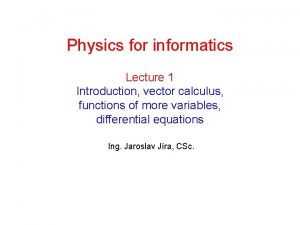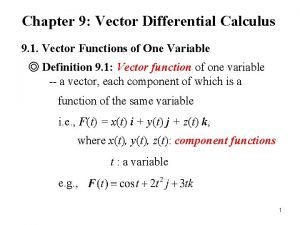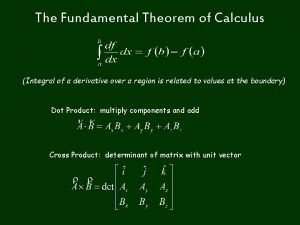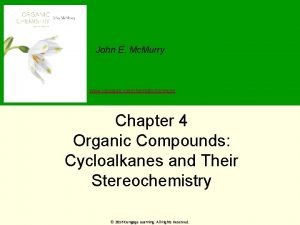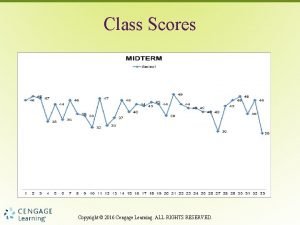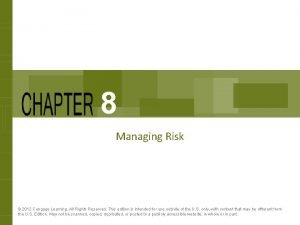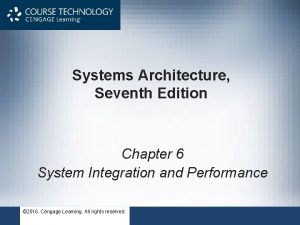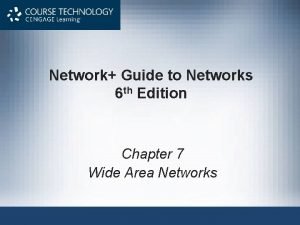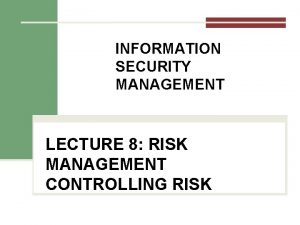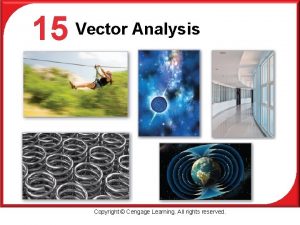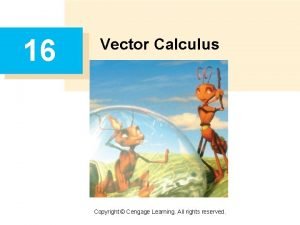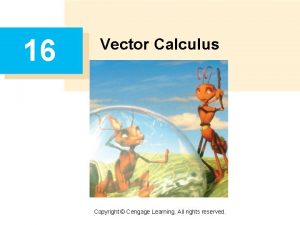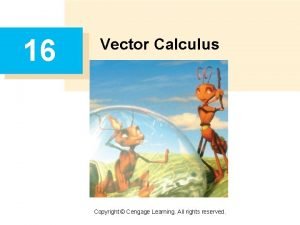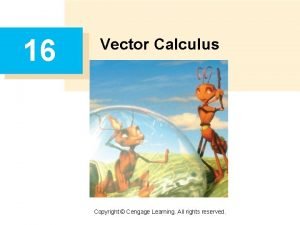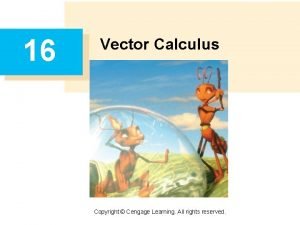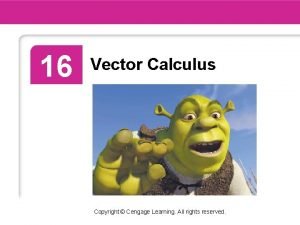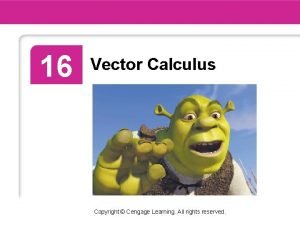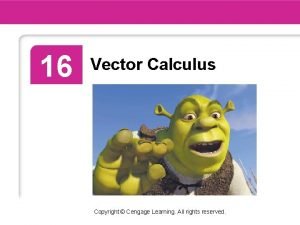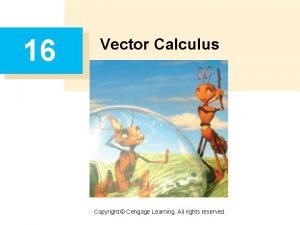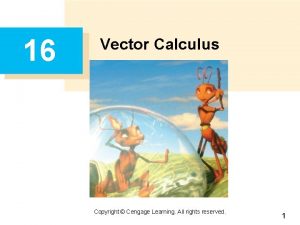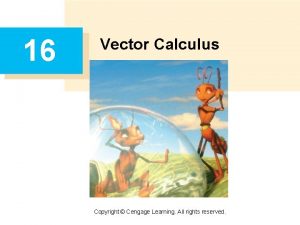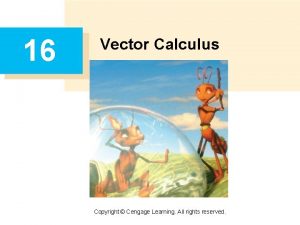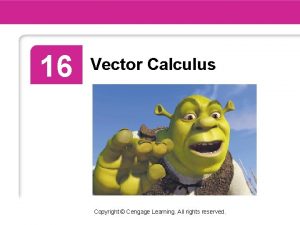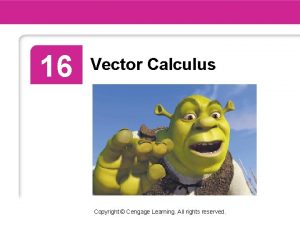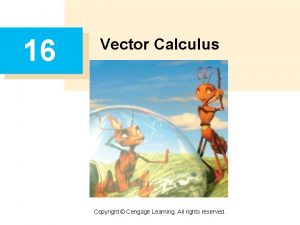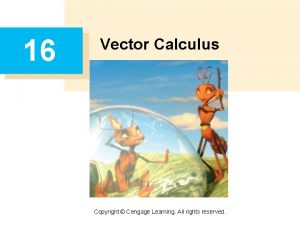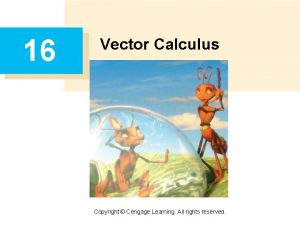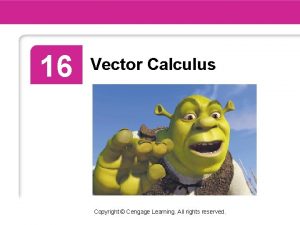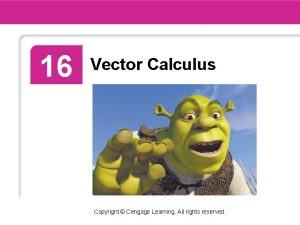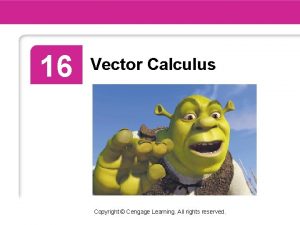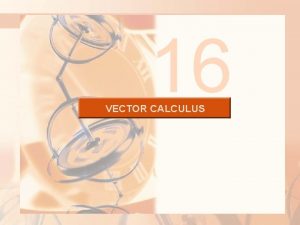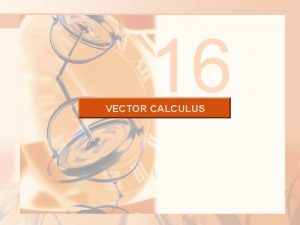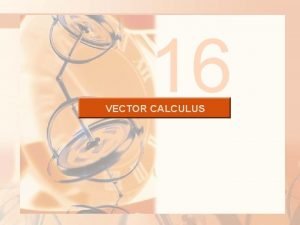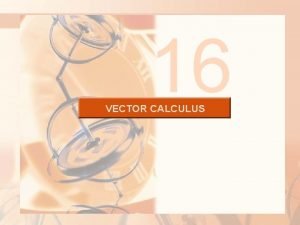16 Vector Calculus Copyright Cengage Learning All rights





















































- Slides: 53

16 Vector Calculus Copyright © Cengage Learning. All rights reserved.

16. 6 Parametric Surfaces and Their Areas Copyright © Cengage Learning. All rights reserved.

Parametric Surfaces and Their Areas Here we use vector functions to describe more general surfaces, called parametric surfaces, and compute their areas. Then we take the general surface area formula and see how it applies to special surfaces. 3

Parametric Surfaces 4

Parametric Surfaces In much the same way that we describe a space curve by a vector function r(t) of a single parameter t, we can describe a surface by a vector function r(u, v) of two parameters u and v. We suppose that r(u, v) = x(u, v)i + y(u, v)j + z(u, v)k is a vector-valued function defined on a region D in the uv-plane. 5

Parametric Surfaces So x, y, and, z, the component functions of r, are functions of the two variables u and v with domain D. The set of all points (x, y, z) in x = x(u, v) such that y = y(u, v) z = z(u, v) and (u, v) varies throughout D, is called a parametric surface S and Equations 2 are called parametric equations of S. 6

Parametric Surfaces Each choice of u and v gives a point on S; by making all choices, we get all of S. In other words, the surface is traced out by the tip of the position vector r(u, v) as (u, v) moves throughout the region D. (See Figure 1. ) A parametric surface Figure 1 7

Example 1 Identify and sketch the surface with vector equation r(u, v) = 2 cos u i + v j + 2 sin u k Solution: The parametric equations for this surface are x = 2 cos u y=v z = 2 sin u 8

Example 1 – Solution cont’d So for any point (x, y, z) on the surface, we have x 2 + z 2 = 4 cos 2 u + 4 sin 2 u =4 This means that vertical cross-sections parallel to the xz-plane (that is, with y constant) are all circles with radius 2. 9

Example 1 – Solution cont’d Since y = v and no restriction is placed on v, the surface is a circular cylinder with radius 2 whose axis is the y-axis (see Figure 2). Figure 2 10

Parametric Surfaces If a parametric surface S is given by a vector function r(u, v), then there are two useful families of curves that lie on S, one family with u constant and the other with v constant. These families correspond to vertical and horizontal lines in the uv-plane. 11

Parametric Surfaces If we keep u constant by putting u = u 0, then r(u 0, v) becomes a vector function of the single parameter v and defines a curve C 1 lying on S. (See Figure 4. ) Figure 4 12

Parametric Surfaces Similarly, if we keep v constant by putting v = v 0, we get a curve C 2 given by r(u, v 0) that lies on S. We call these curves grid curves. (In Example 1, for instance, the grid curves obtained by letting u be constant are horizontal lines whereas the grid curves with v constant are circles. ) In fact, when a computer graphs a parametric surface, it usually depicts the surface by plotting these grid curves, as we see in the next example. 13

Example 2 Use a computer algebra system to graph the surface r(u, v) = (2 + sin v) cos u, (2 + sin v) sin u, u + cos v Which grid curves have u constant? Which have v constant? 14

Example 2 – Solution We graph the portion of the surface with parameter domain 0 u 4 , 0 v 2 in Figure 5 15

Example 2 – Solution cont’d It has the appearance of a spiral tube. To identify the grid curves, we write the corresponding parametric equations: x = (2 + sin v) cos u y = (2 + sin v) sin u z = u + cos v If v is constant, then sin v and cos v are constant, so the parametric equations resemble those of the helix. Thus the grid curves with v constant are the spiral curves in Figure 5. 16

Example 2 – Solution cont’d We deduce that the grid curves with u constant must be curves that look like circles in the figure. Further evidence for this assertion is that if u is kept constant, u = u 0 , then the equation z = u 0 + cos v shows that the z-values vary from u 0 – 1 to u 0 + 1. 17

Example 4 Find a parametric representation of the sphere x 2 + y 2 + z 2 = a 2 Solution: The sphere has a simple representation = a in spherical coordinates, so let’s choose the angles and in spherical coordinates as the parameters. 18

Example 4 – Solution cont’d Then, putting = a in the equations for conversion from spherical to rectangular coordinates, we obtain x = a sin cos y = a sin z = a cos as the parametric equations of the sphere. The corresponding vector equation is r( , ) = a sin cos i + a sin j + a cos k 19

Example 4 – Solution cont’d We have 0 and 0 2 , so the parameter domain is the rectangle D = [0, ] [0, 2 ]. The grid curves with constant are the circles of constant latitude (including the equator). 20

Example 4 – Solution cont’d The grid curves with constant are the meridians (semi-circles), which connect the north and south poles (see Figure 7). Figure 7 21

Parametric Surfaces Note: We saw in Example 4 that the grid curves for a sphere are curves of constant latitude and longitude. For a general parametric surface we are really making a map and the grid curves are similar to lines of latitude and longitude. Describing a point on a parametric surface (like the one in Figure 5) by giving specific values of u and v is like giving the latitude and longitude of a point. 22

Surfaces of Revolution 23

Surfaces of Revolution Surfaces of revolution can be represented parametrically and thus graphed using a computer. For instance, let’s consider the surface S obtained by rotating the curve y = f (x), a x b, about the x-axis, where f (x) 0. Let be the angle of rotation as shown in Figure 10 24

Surfaces of Revolution If (x, y, z) is a point on S, then x=x y = f (x) cos z = f (x) sin Therefore we take x and as parameters and regard Equations 3 as parametric equations of S. The parameter domain is given by a x b, 0 2 . 25

Example 8 Find parametric equations for the surface generated by rotating the curve y = sin x, 0 x 2 , about the x-axis. Use these equations to graph the surface of revolution. Solution: From Equations 3, the parametric equations are x=x y = sin x cos z = sin x sin and the parameter domain is 0 x 2 , 0 2. 26

Example 8 – Solution cont’d Using a computer to plot these equations and rotate the image, we obtain the graph in Figure 11 27

Tangent Planes 28

Tangent Planes We now find the tangent plane to a parametric surface S traced out by a vector function r(u, v) = x(u, v) i + y(u, v) j + z(u, v) k at a point P 0 with position vector r(u 0, v 0). 29

Tangent Planes If we keep u constant by putting u = u 0, then r(u 0, v) becomes a vector function of the single parameter v and defines a grid curve C 1 lying on S. (See Figure 12. ) The tangent vector to C 1 at P 0 is obtained by taking the partial derivative of r with respect to v: Figure 12 30

Tangent Planes Similarly, if we keep v constant by putting v = v 0, we get a grid curve C 2 given by r(u, v 0) that lies on S, and its tangent vector at P 0 is If ru rv is not 0, then the surface S is called smooth (it has no “corners”). For a smooth surface, the tangent plane is the plane that contains the tangent vectors ru and rv, and the vector ru rv is a normal vector to the tangent plane. 31

Example 9 Find the tangent plane to the surface with parametric equations x = u 2, y = v 2, z = u + 2 v at the point (1, 1, 3). Solution: We first compute the tangent vectors: 32

Example 9 – Solution cont’d Thus a normal vector to the tangent plane is Notice that the point (1, 1, 3) corresponds to the parameter values u = 1 and v = 1, so the normal vector there is – 2 i – 4 j + 4 k 33

Example 9 – Solution cont’d Therefore an equation of the tangent plane at (1, 1, 3) is – 2(x – 1) – 4(y – 1) + 4(z – 3) = 0 or x + 2 y – 2 z + 3 = 0 34

Surface Area 35

Surface Area Now we define the surface area of a general parametric surface given by Equation 1. For simplicity we start by considering a surface whose parameter domain D is a rectangle, and we divide it into subrectangles Rij. 36

Surface Area Let’s choose (See Figure 14. ) to be the lower left corner of Rij. The image of the subrectangle Rij is the patch Sij. Figure 14 37

Surface Area The part of Sij the surface that corresponds to Rij is called a patch and has the point Pij with position vector as one of its corners. Let and be the tangent vectors at Pij as given by Equations 5 and 4. 38

Surface Area Figure 15(a) shows how the two edges of the patch that meet at Pij can be approximated by vectors. These vectors, in turn, can be approximated by the vectors and because partial derivatives can be approximated by difference quotients. Approximating a patch by a parallelogram. Figure 15(a) 39

Surface Area So we approximate Sij by the parallelogram determined by the vectors and. This parallelogram is shown in Figure 15(b) and lies in the tangent plane to S at Pij. Approximating a patch by a parallelogram. Figure 15(b) 40

Surface Area The area of this parallelogram is and so an approximation to the area of S is 41

Surface Area Our intuition tells us that this approximation gets better as we increase the number of subrectangles, and we recognize the double sum as a Riemann sum for the double integral 42

Surface Area This motivates the following definition. 43

Example 10 Find the surface area of a sphere of radius a. Solution: In Example 4 we found the parametric representation x = a sin cos y = a sin z = a cos where the parameter domain is D = {( , ) | 0 , 0 2 } 44

Example 10 – Solution cont’d We first compute the cross product of the tangent vectors: 45

Example 10 – Solution cont’d = a 2 sin 2 cos i + a 2 sin 2 sin j + a 2 sin cos k Thus since sin 0 for 0 . 46

Example 10 – Solution cont’d Therefore, by Definition 6, the area of the sphere is 47

Surface Area of the Graph of a function 48

Surface Area of the Graph of a Function For the special case of a surface S with equation z = f (x, y), where (x, y) lies in D and f has continuous partial derivatives, we take x and y as parameters. The parametric equations are x=x y=y z = f (x, y) so and 49

Surface Area of the Graph of a Function Thus we have and the surface area formula in Definition 6 becomes 50

Example 11 Find the area of the part of the paraboloid z = x 2 + y 2 that lies under the plane z = 9. Solution: The plane intersects the paraboloid in the circle x 2 + y 2 = 9, z = 9. Therefore the given surface lies above the disk D with center the origin and radius 3. (See Figure 16. ) Figure 16 51

Example 11 – Solution cont’d Using Formula 9, we have 52

Example 11 – Solution cont’d Converting to polar coordinates, we obtain 53
 Copyright cengage learning. powered by cognero
Copyright cengage learning. powered by cognero Copyright 2015 all rights reserved
Copyright 2015 all rights reserved Copyright 2015 all rights reserved
Copyright 2015 all rights reserved Dell all rights reserved copyright 2009
Dell all rights reserved copyright 2009 Copyright © 2018 all rights reserved
Copyright © 2018 all rights reserved Vector calculus examples
Vector calculus examples Gradient of scalar point function
Gradient of scalar point function Directional derivative in vector calculus
Directional derivative in vector calculus Fundamental theorem of vector calculus
Fundamental theorem of vector calculus Delmar cengage learning medical terminology
Delmar cengage learning medical terminology Cengage chapter 5
Cengage chapter 5 Cengage learning heart diagram
Cengage learning heart diagram South-western cengage learning
South-western cengage learning Chapter 13 medical math assignment sheet
Chapter 13 medical math assignment sheet 2009 delmar cengage learning
2009 delmar cengage learning Cengage learning heart diagram
Cengage learning heart diagram Medical terminology chapter 1 answer key
Medical terminology chapter 1 answer key Cengage learning australia
Cengage learning australia Measuring and recording apical pulse
Measuring and recording apical pulse Whille
Whille Cengage learning
Cengage learning Wadsworth cengage learning
Wadsworth cengage learning Cengage learning
Cengage learning Cengage learning plant cell
Cengage learning plant cell Cengage learning
Cengage learning Cengage learning
Cengage learning Brooks cole cengage learning
Brooks cole cengage learning Chapter 7:10 respitory system
Chapter 7:10 respitory system 2014 cengage learning accounting answers
2014 cengage learning accounting answers Cengage learning
Cengage learning Cengage learning
Cengage learning Chapter 6 skeletal system
Chapter 6 skeletal system Cengage learning
Cengage learning 2009 delmar cengage learning
2009 delmar cengage learning Consumer behavior cengage
Consumer behavior cengage 2012 cengage learning
2012 cengage learning Training evaluation
Training evaluation Cengage learning psychology
Cengage learning psychology Course technology cengage learning
Course technology cengage learning Course technology cengage learning
Course technology cengage learning Course technology cengage learning
Course technology cengage learning Course technology cengage learning
Course technology cengage learning 2016 cengage learning
2016 cengage learning Delmar cengage learning instructor resources
Delmar cengage learning instructor resources 2014 cengage learning
2014 cengage learning 2010 cengage learning
2010 cengage learning Copyright r vector
Copyright r vector Negative rights vs positive rights
Negative rights vs positive rights Littoral rights include
Littoral rights include Duty towards self
Duty towards self Legal rights and moral rights
Legal rights and moral rights Negative rights
Negative rights Negative rights
Negative rights Negative rights vs positive rights
Negative rights vs positive rights






